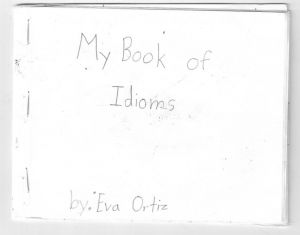Standards
Scroll to the ELA standards.Summary
Idioms can be tough to explain. I mean, you’re basically saying, “This combination of words means something totally different than what the actual words mean.” As we’ve built out language arts elements in both our upcoming Making Camp Premium and AzTech apps, we asked teachers what they thought we should cover (especially keeping in mind AzTech is also intended for ELL students to use). Idioms kept coming up again and again, so we made sure to put them in.
Let’s begin on what an idiom can be described as: a common phrase with a different meaning other than the literal meaning of the words. Idioms can be hard to explain because unless you actually know the meaning of idiom, it may make absolutely no sense. You think, “What can I do to teach about idioms now?” Don’t worry, we’ve got a fun activity: An idioms book.
What you’ll need:
- Pre-made booklets for the kids
- Pencil for writing and drawing
- Colored pencils or crayons
- Idioms Videos (provided below)
There’s a few different ways you can tackle this activity – and the best part is all of them are right. Have different groups of kids study one group of idioms and then rotate them. Have kids illustrate idioms to record in a Book of Idioms. The video below provides you with idioms.
Video Lesson: Idioms
This three-minute video defines idioms and provides examples of them.
Idioms Provided:
- costs an arm and a leg
- to bite your tongue
- going bananas
- on thin ice
- in hot water
- smells fishy
- it’s a piece of cake
- under the weather
- raining cats and dogs
- more than you can shake a stick at
- to drive up the wall
Technology required
- A device to play the Idioms video (or you can source your own)
Activity
After you’ve taught the lesson, have the kids write the idiom and what it actually means (this reinforces the memorization of the idiom’s meaning), and then have kids draw pictures in their book of idioms. Have them illustrate what the idiom suggests. See what kind of fun depictions they come up with for things like, “Cool as a cucumber” and “Going bananas!”
For example, check out this from Eva’s Book of Idioms:
Hitting the books does not literally mean that one actually hits a book but in fact, “goes to study.”
A graveyard shift doesn’t really mean someone working a shift at a graveyard but “working when most people are asleep.”
Here’s a couple more.
Now’s your turn! It’s simple! All you need is a few things you likely have around the classroom or house to help you create your very own Book of Idioms!
Standards
Grades 3-5
CCSS.ELA-LITERACY.RL.3.4
Determine the meaning of words and phrases as they are used in a text, distinguishing literal from nonliteral language.
CCSS.ELA-LITERACY.L.4.5
Demonstrate understanding of figurative language, word relationships, and nuances in word meanings.
CCSS.ELA-LITERACY.L.4.5.B
Recognize and explain the meaning of common idioms, adages, and proverbs.
CCSS.ELA-LITERACY.RL.5.4
Determine the meaning of words and phrases as they are used in a text, including figurative language such as metaphors and similes.






Pingback: Vocab Cards: Animal Names in Spanish - Educational Resources for Grades 3-8
Pingback: Animal Idioms - Educational Resources for Grades 3-8